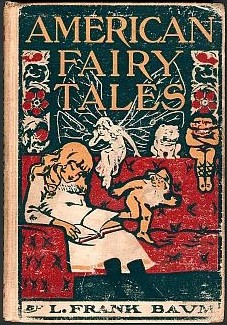American Fairy Tales facts for kids

First edition
|
|
| Author | L. Frank Baum |
|---|---|
| Illustrator | Norman P. Hall Harry Kennedy Ike Morgan Ralph Fletcher Seymour |
| Country | United States |
| Language | English |
| Genre | Fantasy Humor |
| Publisher | George M. Hill Company |
|
Publication date
|
1901 |
| Media type | Print (hardcover) |
American Fairy Tales is a collection of twelve fun fantasy stories written by L. Frank Baum. He is the same author who wrote The Wonderful Wizard of Oz. This book was published in 1901 by the George M. Hill Company.
The book's cover and special page designs were created by Ralph Fletcher Seymour. Each story also had two black-and-white pictures. These pictures were drawn by Harry Kennedy, Ike Morgan, or Norman P. Hall.
Contents
About the Author and Book
How L. Frank Baum Wrote These Stories
In 1901, L. Frank Baum was a very popular writer. He had already written two successful books: Father Goose: His Book and The Wonderful Wizard of Oz. He wanted to keep writing more exciting stories!
Besides American Fairy Tales, Baum also released two other books in 1901. These were Dot and Tot of Merryland and The Master Key.
Stories in Newspapers First
Before the book came out, the twelve stories from American Fairy Tales appeared in newspapers. Five big newspapers bought the rights to print them. These included the Pittsburgh Dispatch and The Boston Post.
The stories were printed between March and May of 1901. The full book then came out in October of that year. Some newspapers used the same pictures as the book. Others had their own artists draw new ones.
Book's Special Look
The first edition of American Fairy Tales had a very unique design. Every page had a wide, decorated border. These borders were drawn by Ralph Fletcher Seymour.
They looked a bit like old, fancy hand-made books from the Middle Ages. This special design made the book look very artistic and beautiful.
The Stories Inside
There are twelve stories in the first edition of American Fairy Tales. Here they are in order:
- "The Box of Robbers." Pictures by Ike Morgan.
- "The Glass Dog." Pictures by Harry Kennedy.
- "The Queen of Quok." Pictures by Ike Morgan.
- "The Girl Who Owned a Bear." Pictures by Harry Kennedy.
- "The Enchanted Types." Pictures by Ike Morgan.
- "The Laughing Hippopotamus." Pictures by Ike Morgan.
- "The Magic Bon Bons." Pictures by Ike Morgan.
- "The Capture of Father Time." Pictures by Harry Kennedy.
- "The Wonderful Pump." This story had pictures by N. P. Hall.
- "The Dummy That Lived." Pictures by Ike Morgan.
- "The King of the Polar Bears." Pictures by Ike Morgan.
- "The Mandarin and the Butterfly." Pictures by Ike Morgan.
What Makes These Stories Different?
These stories are a bit different from some of Baum's other fantasy tales. They often have funny or silly lessons at the end. They are more like jokes or playful stories than serious fairy tales. This is why they were a good fit for newspapers, which adults also read.
"The Magic Bon Bons" was the most popular story. It was printed many times!
Two stories, "The Enchanted Types" and "The Dummy That Lived," feature special fairies. These fairies are called knooks and ryls. Baum later used them in his book The Life and Adventures of Santa Claus. "The Dummy That Lived" is about a store mannequin that comes to life. This idea has been used in many movies and TV shows since then!
Later Versions of the Book
New Publishers and Pictures
The company that first published the book, George M. Hill, closed down in 1902. Another company, Bobbs-Merrill, then bought the rights to Baum's books.
In 1908, Bobbs-Merrill released a second edition of American Fairy Tales. It had a new cover and new pictures. George Kerr drew sixteen new two-color illustrations. These replaced the original ones by Morgan, Kennedy, and Hall.
More Stories Added
This second edition also included a note from L. Frank Baum himself. Plus, it added three brand new stories! These were "The Strange Adventures of an Egg," "The Ryl," and "The Witchcraft of Mary-Marie."
A third edition came out around 1923-1924. It had fewer color pictures but kept the book available until 1942. The order of the stories was also changed in this edition.
Stories on Screen
L. Frank Baum himself turned two of these stories into short films. These were "The Box of Robbers" and "The Magic Bon Bons." They were part of his lost film series called Violet's Dreams. The actress Violet MacMillan played the main child character in both. "The Box of Robbers" was renamed A Box of Bandits for the film.
Baum also started working on a play version of "The Glass Dog." However, it was never finished or performed. Later, in 2008, "The Glass Dog" was made into a comic book story. It appeared in the fifteenth issue of Graphic Classics.

